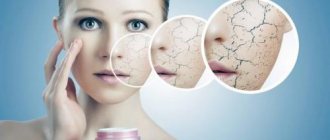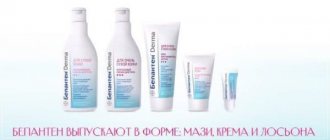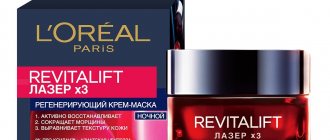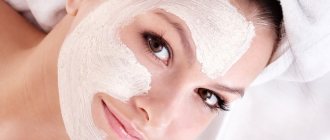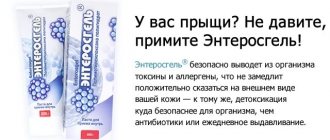Issues discussed in the material:
- Causes of dry facial skin
- The first signs of dry skin
- Nutrition system for dry skin
- The best vitamins for dry skin
- Oils for dry skin
- General rules for caring for dry skin
Vitamins for dry skin will help you quickly get it in order. If you are faced with such a problem, then first of all it is important to understand that dryness can be temporary or permanent. If periodic peeling causes discomfort, then most likely you have a lack of moisture in the body or damage to the hydrolipid mantle of the skin.
But don’t despair, you can get your face in order, and quite quickly. Special oils and various vitamins are sold for this purpose. Today we will tell you how to determine the cause of dryness and advise how to improve the condition of your facial skin with the help of cosmetics and vitamin complexes.
Causes of dry facial skin
Skin type depends on genetic predisposition. In cases where an insufficient amount of sebum is produced, the hydrolipid layer becomes thinner. As a result, the skin is dry, vulnerable, unable to retain moisture, sensitive to external irritants, and its integrity is very easy to damage.
But dryness and dehydration are not the same thing. Dehydration occurs when there is an acute lack of water. The skin tries to correct the situation and begins to produce fat in order to somehow compensate for the lack of moisture (while dry skin lacks fat).
Recommended reading:
- What not to do after eyelash extensions
- Which eyelash extension to choose for yourself
- Eyelash care: advice from professionals
Dehydration occurs due to lack of care or incorrectly selected cosmetics, due to unfavorable weather conditions, poor nutrition, etc. This can happen to both oily and dry skin.
Dehydrated skin, prone to oiliness, often has inflammation and comedones.
Dry skin suffers from the appearance of premature wrinkles.
There are many reasons for dryness. This may be a sign of a disease, such as atopic dermatitis, or a deficiency of vitamins in the body. For dry or oily facial skin, nutrient imbalance is very critical. In these cases, consultation with a dermatologist will be required. But there are more common cases.
Let's take a closer look:
- Frequent cleansing of the facial skin with aggressive cosmetics. Using makeup removers that adversely affect the hydrolipidic layer.
- Improper care or lack thereof. Insufficient hydration and nutrition of the skin or the use of low-quality (unsuitable skin type) cosmetics.
- Peels, exfoliations, use of aggressive scrubs. Even daily shaving can cause dryness due to regular damage to the hydrolipidic mantle.
- Exposure to weather conditions (extreme frost, wind or heat).
- Dryness in the room during central heating operation. A common problem in our latitudes in winter.
When does vitamin deficiency occur?
Vitamin deficiency, or vitamin deficiency, can occur at any age, but children, pregnant women and the elderly are most susceptible to it. Often the skin reacts to a lack or excess of nutrients with increased dryness, peeling, and irritation, which can appear on any part of the body: legs, arms, back, chest and head.
The lack of certain substances is seasonal, for example, in the cold season (autumn and winter), the risk of vitamin deficiency increases due to a decrease in the consumption of fresh vegetables and fruits enriched with vitamins and minerals. Accordingly, in summer and spring their consumption increases and the body replenishes the vitamin deficiency. Adhering to strict diets and food restrictions, the skin also suffers from vitamin deficiency, which affects its appearance.
The first signs of dry skin
Dry skin type can be determined by the following signs:
- feeling of tightness when touched;
- peeling;
- itching and redness after water treatments.
Dryness often occurs due to a lack of vitamins. This can be noted by such signs as the appearance of cracks in the corners of the mouth. A lack of vitamins A and E can be determined by the condition of the skin of the elbows - it becomes excessively rough and tough. But the deficiency state is diagnosed only by a dermatologist when prescribing the appropriate tests.
An analysis for vitamin deficiency can be carried out by any laboratory in your city. But only a dermatologist can correctly evaluate the results and prescribe vitamins for dry skin.
The risk of developing vitamin deficiency increases in the following cases:
- smoking;
- frequent consumption of alcoholic beverages;
- adherence to strict restrictive diets;
- problems in the functioning of the gastrointestinal tract;
- age over 40 years.
Properties of vitamin B2. What does the body need?
The properties of vitamin B2 are many, but the main thing can be highlighted: it affects the release of energy from nutrients, and also ensures the beauty and health of the skin, eyes and hair:
- it plays a role in the overall metabolism of carbohydrates, fats and proteins from food, promoting the release of energy; present in the body in the form of two coenzymes: FAD (flavin adenine dinucleotide) and FMN (flavin mononucleotide), which act as hydrogen acceptors; their combined action with enzymes ensures the oxidation of glucose, which leads to the release of energy
- plays a role in respiration mechanisms at the cellular level
- plays a major role in the retina of the eye, promoting healthy vision and vision in the dark
- promotes growth
- plays a leading role in the health of skin, hair (acts on the elasticity and strength of keratin fibers) and nails
- increases the body's resistance to cold
- important for the proper functioning of the nervous system and brain.
Nutrition system for dry skin
Often, when dry skin occurs, its owners seek to eliminate the problem with cosmetics.
However, first of all, you need to understand your lifestyle and nutrition. After all, health problems start from within.
Bringing dry skin back to normal will be faster and easier if you eat the right foods. Pay attention to a few simple tips:
- The daily diet should be balanced in terms of the ratio of proteins, fats and carbohydrates. No need to skip breakfast, it starts your metabolism. It is better if breakfast is protein. During the day, three main meals and a couple of snacks are allowed.
- There are no strict restrictions on the consumption of products. But it is better to exclude large amounts of sugar and caffeine from your diet. Under their influence, the skin loses its tone and becomes wrinkled ahead of time.
- Remember that coffee acts as a diuretic, removing fluid from the body. This is unacceptable for dry skin.
- Make sure you drink your normal amount of clean water per day. This is about 2 liters.
It is important to supplement the diet with such beneficial vitamins for dry skin as A, E, B, C. Omega-3 and 6 fatty acids are very useful.
Products filled with useful substances:
- lean meat (chicken, turkey, rabbit);
- legumes;
- seafood;
- carrot;
- broccoli;
- pumpkin;
- tomatoes;
- spinach;
- greens (parsley, dill);
- linseed oil;
- egg yolk;
- liver;
- dairy and fermented milk products.
When dry skin appears for a number of natural reasons (weather influence, type of epidermis), it is important not to forget about prevention.
Work done in our studio “Anna Klyuchko”. Sign up for eyelash extensions
Drink more filtered water, use gel instead of soap, and regularly apply nourishing and moisturizing products.
Protect your skin from exposure to cold winds. Apply nourishing cream before going outside. More information about skincare products can be found on women's forums. Participants generously share their experiences on the Internet.
How can you compensate for the lack of vitamins?
Vitamins enter the human body with food in insufficient quantities to fully support organs. Therefore, in order for the skin to remain healthy, fresh, moisturized and youthful longer, an integrated approach is needed: a balanced diet, consumption of biologically active supplements to the daily diet, and a beauty routine enriched with vitamins.
- Cosmetics with vitamins The most highly concentrated formulas are face creams and serums. The compositions of these products can combine several vitamins at once or have a mono-vitamin base. The composition should be selected based on the type, condition and needs of the skin.
- Cosmetic procedures Aesthetic procedures based on injections, for example, biorevitalization, mesotherapy, involve the delivery of a vitamin complex with hyaluronic acid to the deep dermal layers. Alternative non-invasive methods of skin vitaminization are electroporation and non-injection mesotherapy.
- Vitamin-mineral complexes Dietary supplements enrich the body with nutrients, in particular, they help nourish the skin with vitamins from the inside and make up for the lack of useful components coming from food.
- Nutrition The easiest way to fortify the body is a balanced diet. Enrich your diet with fresh fruits and vegetables, herbs, berries, nuts, cereals - these products are high in nutritional components and have a positive effect on the skin.
The best vitamins for dry skin
Skin problems often arise due to a deficiency of microelements in the body. It is important to eat a balanced diet so that a sufficient amount of vitamins enters the body with foods; this is simply necessary for dry facial skin.
- Vitamin C (ascorbic acid)
Vitamin C is included in almost all cosmetic products. First of all, because it is a powerful antioxidant. It protects against ultraviolet radiation, increases the body's immune strength, stimulates collagen production, fights pigment spots and inflammation. Vitamin C is found in maximum quantities in foods such as bell peppers, kiwi, citrus fruits and black currants.
- Vitamin E (tocopherol)
You can list the functions of this vitamin endlessly. Here are the main ones: protection against photoaging, activation of the production of collagen and elastin synthesis, return to normal functioning of the sebaceous glands, fight against free radicals, increasing the level of moisture. The largest amount of tocopherol is in plant oils.
Sign up for eyelash extensions at Anna Klyuchko's studios with a 15% discount until March 7
12 studios throughout Moscow, St. Petersburg, Nizhny Novgorod and Tula
223 masters for every taste
High-quality service with a 7-day guarantee
Regular promotions and gifts for clients
Full volume 1990₽ 1692₽ Double volume 2590₽ 2202₽ Triple volume 2890₽ 2457₽ Hollywood volume 3400₽ 2890₽
Book 15% discount
- Vitamin B5 (panthenol)
Panthenol accelerates the healing processes of burns and wounds, and moisturizes the skin. It is found in a large number of foods, such as egg yolks, bread, nuts, fish, etc.
- Vitamin H (vitamin B7, biotin)
The second name along with vitamin E is the beauty vitamin. Biotin ensures the integrity of the hydrolipid mantle. If it is not enough, problems appear in the form of dryness, dullness, and flaking. It is enough to include dishes from liver, cauliflower, mushrooms and broccoli in the menu to overcome negative conditions.
Vitamins are organic compounds that have various structures that are necessary for life (from the Latin “vita” - “life”) in small quantities, because the body does not produce them or produces them in insufficient quantities.
Essential fatty acids, sometimes called vitamin F, and essential amino acids are not included.
Initially, it was believed that all vitamins consist of amines - hence the second part of the term - “amine”
. However, this rule no longer applies to vitamins known today.
Humans and the animal world have different needs for vitamins. Some animal species are capable of producing vitamin C themselves. The lower the evolutionary stage of the organism, the more developed the ability to synthesize vitamins. This is why plant foods can fully satisfy a person’s vitamin needs. Positioned as vitamin-like substances contained in dietary supplements, they are only relevant for the marketing of the corresponding product.
Availability
Vitamins control metabolic processes, perform protective and other vital functions, and are important for the immune system. Vitamins enter the body with daily nutrition and are partially absorbed due to the activity of intestinal microflora. In addition to free vitamins, their derivatives or provitamins are also absorbed: derivatives are compounds of vitamins with other substances. They are often esters with acids such as acetic and palmitic acids. For example: tocopherol acetate (name according to the International Nomenclature of Cosmetic Ingredients INCI: Tocopheryl Acetate), tocopherol palmitate (name according to the International Nomenclature of Cosmetic Ingredients INCI: Tocopheryl Palmitate). In these cases, the vitamin already has its final structure and can only be released into tissues with the help of hydrolyzing enzymes. Derivatives
are generally less sensitive to atmospheric conditions.
As esters (lipophilic), they are easily absorbed and can be used in skin care products in low doses. Provitamins
are biochemical precursors of vitamins, the structure of which undergoes biochemical transformations in the body. A typical example is beta-carotene, from which vitamin A and vitamin A acid (retinoic acid) are gradually formed.
There are water-soluble
(hydrophilic) and
fat-soluble
(lipophilic) vitamins. The higher the solubility in lipids, the better the absorption and accumulation of vitamins. Water-soluble vitamins in high doses are sometimes excreted unchanged. This is especially true for vitamin C. When applied externally, it all depends on the “packaging”. Free vitamin C has only a superficial effect on the skin, like fruit acid, or can act as an antioxidant in a cosmetic product. A significant effect on the skin can only be achieved with the help of penetration enhancers - liposomes (hydrophilic) or nanodispersions (lipophilic).
Fig.1. Vitamins KOKO dermaviduals®. For effective delivery into the deep layers of the skin, vitamins are enclosed in transdermal carriers: liposomes and nanoparticles based on phosphatidylcholine. Due to the high content of linoleic acid, the particles have their own reducing activity.
Natural springs
In many cases, cosmetics often use raw materials that already contain vitamins as natural impurities. In this regard, mention should be made of fatty oils such as wheat germ oil, avocado oil or extracts. For the skin, it does not matter whether vitamins are natural or synthesized, as long as their molecules are chemically identical.
Rice.
2 Natural sources of vitamins: avocado (Persea gratissima), jojoba (Buxus Chinensis), wheat germ (Triticum vulgare), wild rose fruit (Rosa Mosqueta). However, this is not always the case. Natural forms of tocopherol (vitamin E), alpha, beta, gamma and delta tocopherols, while the basic structure is similar, differ in the number and location of methyl groups. Each of these tocopherols, in turn, can occur in two mirror d- and l-forms. d-α-tocopherol has the highest biological activity and in the narrow sense of the word is often called vitamin E. Synthetic vitamin E is usually a mixture of d-α-tocopherol and l-α-tocopherol in a 1:1 ratio. Fig.3. KOKO dermaviduals® caring oils with a high content of vitamins. The oils are obtained by cold pressing (squeezing), which retains all the beneficial substances: unsaturated fatty acids and vitamins, carotenoids, sterols, which guarantees the high biological activity of the oils in skin care. The content is 99.8%, stabilized by a small amount of vitamin C and E.
Dosage
Since vitamins are consumed in the body in the process of performing their functions, their reserves must be constantly replenished. This applies to the body in general, and to the skin in particular. Local applications, compared to oral administration, have the advantage that the doses in absolute terms will be small, but locally in relation to the area in which they are applied, relatively high. For example, topical application of vitamin A allows you to control the effects of retinoic acid, which is formed due to the oxidation process in the epidermis. Antioxidant vitamins such as C and E are used in large quantities as antioxidants in foods and cosmetics.
More about vitamins
Vitamin A
Vitamin A (retinol): includes a group of chemical compounds that have similar activities and are called retinoids. Retonoids are found only in animal products; plant products contain vitamin A precursors - carotenoids. There are a number of derivatives and provitamins:
- Retinyl acetate, retinyl palmitate and retinyl propionate are esters of vitamin A. They are broken down enzymatically in the skin.
- retinal - differs from retinol by the presence of an aldehyde group - retinaldehyde. Important for vision. Like Retinol, Retinal is oxidized in the skin to retinoic acid.
- Beta-carotene (provitamin A), the pigment of carrots, is enzymatically hydrolyzed into two molecules of vitamin A. The carotenoid family consists of a variety of fat-soluble tetraterpenes ranging in color from red through orange to yellow (tomatoes, peppers, rose hips, oranges, etc.). When taken orally in large doses over a long period of time, beta-carotene develops weak photoprotection, but does not replace a UV filter. In food it is a popular coloring agent.
- 3-dehydro-retinol is found in the liver of cold-water fish and is called vitamin A2.
- All retinoids are sensitive to atmospheric oxygen. Therefore, cosmetic preparations based on them should not be used under direct sunlight. Their effect on the skin is largely the result of the conversion of retinoids to retinoic acid.
While retinoic acid was banned for use in skin care products for many years, it is approved in dermatology under the name tretinoin. Isotretinoin differs from tretinoin in a spatially divergent arrangement of the acid group (cis instead of trans location). Areas of application of retinoids:
- hyperkeratoses and scars;
- problematic skin and acne, disruption of keratinization processes in the ducts of the sebaceous glands;
- stimulation of cell growth and collagen synthesis in epithelial tissue;
- aging skin - often in combination with vitamins E and C.
Retinoids have a threshold of irritation, meaning that at higher concentrations and frequent use, typical effects of retinoic acid, such as severe skin erythema, can be observed. With increasing duration of treatment, the number of vitamin A receptors increases. Therefore, it is recommended to start with small doses and then gradually increase the concentration. Oral overdose may have a teratogenic effect in pregnant women. This fact must be taken into account when preparing the diet for pregnant women. With moderate cosmetic use, systemically significant concentrations cannot be achieved. However, the BfR (Federal Institute for Risk Assessment, Germany) recommends limiting vitamin A in face and hand skin care products.
Fig.4. Structural formula of vitamin A. Vitamin A-Nanopartikel - vitamin A in nanoparticles (KOKO dermaviduals®) for the care of mature and sun-damaged skin. Stimulates skin renewal, enhances collagen synthesis. Increases skin density and elasticity. Effective in the treatment of many skin diseases (acne, psoriasis).
B vitamins
Vitamin B1 (thiamine) is a water-soluble and natural ingredient in cereal and yeast extracts.
In aqueous solutions it is deactivated by heating. As a coenzyme component, the vitamin plays an important role in carbohydrate metabolism. For cosmetic purposes, it is used as a salt (hydrochloride) and often in combination with other B vitamins (vitamin B complex) to treat damaged skin. Vitamin B2 (riboflavin) sources are yeast, milk, liver and other substances. The vitamin is involved in the formation of numerous oxidoreductases. Used as a yellow dye (E 101) in food and cosmetic products.
Vitamin B3 (niacin) occurs as niacin or nicotinamide (INCI: niacinamide). Contained in unprocessed foods (meat, grains). It is part of the dehydrogenases: coenzymes NAD and NADP and is involved in biochemical redox reactions. The vitamin is reabsorbed as niacin in the intestinal tract. Used in cosmetic products to restore skin. Niacinamide is a powerful anti-inflammatory agent.
Vitamin B5 (pantothenic acid): found in milk, liver and vegetables. Component of coenzyme A. In the cosmetic field, both a calcium salt (INCI: calcium pantothenate) and an easily penetrating provitamin (D-panthenol) are used, which is oxidized in the skin to pantothenic acid.
Areas of use:
- increasing skin moisture content
- treatment of inflammatory processes
- epithelization of affected skin
- itching suppression
- hair treatment
Vitamin B6 (pyridoxine) is found in three forms: pyridoxine, pyridoxal with an aldehyde group, pyridoxamine with an aminomethyl group, which are approximately identical in their biological activity.
Contained in many products. There is especially a lot of vitamin B6 in grain sprouts, nuts, spinach, potatoes, carrots, cabbage, tomatoes, strawberries, cherries, oranges and lemons. Vitamin B6 is also found in meat and dairy products, fish, liver, eggs, cereals and legumes. It is a coenzyme of proteins that participate in the metabolism of amino acids and stimulates metabolism. Vitamin B6 deficiency leads to various forms of dermatitis. Pyridoxine hydrochloride is predominantly used in skin care products. Vitamin B7 (biotin, coenzyme R, sometimes called vitamin H). The molecule has a double ring structure. The former term "vitamin H" refers to its importance for the skin. It is part of enzymes that regulate protein and fat balance and has high biological activity. Participates in carbohydrate metabolism. It is a source of sulfur, which takes part in collagen synthesis. Vitamin deficiency leads to skin lesions, dryness and unhealthy tone, and deterioration of hair condition. The consequences are hair loss and dermatitis. Biotin is resistant to ultraviolet rays.
Vitamin B9 (folic acid): A water-soluble vitamin rich in nitrogen. Found in vegetables, liver and grains. Along with folic acid, vitamins also include its derivatives, di-, tri-, polyglutamates and others. They are all collectively called folates. The main function of folic acid and its derivatives is the transfer of one-carbon groups (for example, methyl and formyl) from one organic compound to another. The main active form of folic acid, tetrahydrofolic acid, is produced by the enzyme dihydrofolate reductase. Folic acid is involved in DNA synthesis. Necessary for the growth and development of the circulatory and immune systems.
Vitamin B12 (cobalamin) is a group of cobalt-containing biologically active substances called cobalamins. These include cyanocobalamin itself, hydroxocobalamin and two coenzyme forms of vitamin B12: methylcobalamin and cobamamide. Can be synthesized only by microorganisms living in the intestinal tract of animals. Lack of vitamin B12 can develop in vegetarians and vegans; in addition, colonization of the intestines with strains of pathological bacteria prevents the resorption of this vitamin. The vitamin as such is inactive and is activated only after conversion to coenzyme B12. Coenzyme B12 is a catalyst for specific restructuring reactions in the body. Its use in cosmetic products is controversial, with the molecule believed to be capable of binding nitric oxide. This function, however, can be assigned to the amino acids of the NMF complex.
Fig.5. Structural formula of vitamin B3 (niacinamide) Vitamin-B-Liposomen-Konzentrat - a concentrate with B vitamins in liposomes (KOKO dermaviduals®) for intensive care for problematic, oily skin, skin with acne and post-acne; in anti-age programs, vascular pathologies, pigmentation. Stimulates regeneration, increases immunity, reduces sebum production, evens out tone, increases skin hydration.
Vitamin C (ascorbic acid)
A water-soluble vitamin widely available in fruits and vegetables.
This vitamin is involved in the biosynthesis of collagen, as well as in many metabolic processes associated with steroids, amino acids and catecholamines. Main tasks in cosmetology:
- protection of cosmetic components (antioxidant);
- neutralization of free radicals;
- the keratolytic effect of free concentrated ascorbic acid at low pH is similar to the effect of AHA acids (alpha hydroxy acids);
- prevention of hyperpigmentation;
- stimulation of collagen synthesis.
While the first three tasks are carried out due to the action of free ascorbic acid, in relation to the other two tasks, a significant effect is possible only through derivatives - free ascorbic acid is unstable, in the form of polar molecules it practically does not penetrate the skin. Derivatives and media should be used as follows:
- Ascorbyl phosphate is used in the form of sodium or magnesium salts. It is a water-soluble ester of vitamin C with phosphoric acid, which is enzymatically broken down after passing through the skin barrier. The carriers are phosphatidylcholine liposomes.
- Ascorbyl palmitate and ascorbyl stearate and the corresponding variety of esters are fat-soluble options specially packaged in nanodispersions of phosphatidylcholine, which also enhances penetration. Esters are enzymatically broken down by doascorbic, palmitic or stearic acids. Phosphatidylcholine as an endogenous material is compatible with all barrier and cellular structures of the body.
When the ether is broken down, only those substances that are naturally present in the skin are formed. In practice, the difference in the use of free ascorbic acid can be observed during laser hair removal: applied before hair removal, free ascorbic acid turns brownish and has virtually no effect on the synthesis of melanin, while liposomal sodium ascorbyl phosphate completely suppresses the formation of melanin. To achieve this effect, a concentration of 0.1% is sufficient.
Fig.6. Structural formula of vitamin C. Vitamin C-Liposomen-Konzentrat - vitamin C in liposomes (KOKO dermaviduals®). Vitamin C concentrate for all skin types, as well as for the care of skin with rosacea and the prevention of hyperpigmentation. Stimulates collagen synthesis, has high antioxidant activity, and is effective in preventing aging.
Vitamin D (calcitriol)
The most important sources of vitamin D are provitamin D2 (ergosterol), found mainly in mushrooms and wheat germ flour, and provitamin D3 (7-dehydrocholesterol), found in egg yolk, liver and fish oil.
Vitamins D2 (ergocalciferol) and D3 (cholecalciferol) are formed under the influence of sunlight from provitamins D2 and D3. They are transported to the liver and converted to 25-hydroxycholecalciferol (calcidiol). Once transported to the kidneys through the bloodstream, it becomes the active form of vitamin D (1.25 - dihydroxycholecalciferol = calcitriol). From there, it is transported again through the bloodstream to target organs, where it binds to proteins. Calcitriol regulates the metabolism of calcium and phosphate in the small intestine, bones and kidneys. The European Cosmetics Directive prohibits the use of vitamin D2 (ergocalciferol) and vitamin D3 (cholecalciferol). However, this ban does not apply to provitamins that are approved for use in skin care products in the United States. A number of skin effects associated with vitamin D exposure have been described:
- affects the differentiation and growth of keratinocytes, this function plays an important role in the treatment of psoriasis;
- participates in maintaining the calcium gradient in the skin;
- stimulates the formation of antimicrobial peptides such as defensins and cathelicidins. The influence of these peptides is important in inflammatory processes associated with atopic dermatitis;
- prolongs skin self-protection during exposure to UV radiation, stimulates heat shock proteins;
- Cases of repigmentation of vitiligo have been described with applications of calcitriol or vitamin D analogues under the influence of ultraviolet radiation.
Fig.7. Structural formula of vitamin D (calcitriol).
Vitamin E
Vitamin E (d-α-tocopherol): belongs to the group of fat-soluble vitamins, just like vitamins A, D and K. Vitamin E is a natural antioxidant present in all unsaturated vegetable oils. In this regard, wheat germ oil takes a leading position. An important physiological function of this vitamin is the protection of oxygen-sensitive cellular components such as omega-3 and omega-6 fatty acids. In the cosmetic field, free vitamin and its derivatives are used. By derivatives we mean esters of organic acids. Since esterification occurs on phenolic hydroxyl groups, they do not have antioxidant effects. Therefore, they do not protect drugs, but behave as stable compounds that, after passing the skin barrier, are cleaved by esterase. During the cleavage of the ester, its antioxidant properties are reactivated. The following vitamin E derivatives are important:
- tocopheryl acetate is an ester of acetic acid;
- tocopheryl palmitate is an ester of palmitic acid;
- tocopheryl linoleate (linoleic acid ester) demonstrates a combination of antioxidant action with the action of essential omega-6 acid;
- Tocopheryl nicotinate (nicotinic acid ester) is a combination of vitamin E with vitamin B3. The ester supports microcirculation in the skin without the characteristic features of short niacin esters: generating heat or erythema.
The following properties of vitamin E are used in cosmetics:
- antioxidant effects and free radical scavenging ability - in this context, it is important to choose an appropriate concentration, since high concentrations will induce pro-oxidant properties of vitamin E;
- protection of vitamin A and its derivatives in combination with vitamin C (synergistic action);
- Due to its ability to scavenge free radicals, exposure to UV radiation is minimized. The same applies to inflammatory processes;
- stimulation of cell formation (epithelialization);
- the moisture-holding capacity of the skin increases.
Fig.8. Structural formula of vitamin E. Vitamin E-Nanopartikel - vitamin E in nanoparticles (KOKO dermaviduals®). Vitamin E concentrate for the care of normal, dry and mature skin. The main antioxidant of the skin. Protects against free radicals and UV radiation, slows down the aging process, and normalizes water content in the skin.
Vitamin K
Vitamin K is a fat-soluble vitamin and is found in two natural forms - vitamin K1 (phylloquinone; 2-methyl-3-phytyl-naphthoquinone) and vitamin K2 (menaquinone, 2-methyl-3-difarnesyl-1, 4-naphthoquinone).
The phytyl side chain of vitamin K1 corresponds to a monoterpene with 20 carbon atoms. Unlike vitamin K1, vitamin K2 can have different lengths of terpene side chains. Vitamin K1 is mainly absorbed from plant foods, while vitamin K2 is synthesized by intestinal bacteria such as E. coli. Accordingly, if the balance of the intestinal microflora is disturbed due to antibiotic treatment or is not yet stable (for example, in newborns), this can cause a deficiency of vitamin K. Vitamin K is a blood clotting factor and, among other things, maintains stable circulatory characteristics. Vitamin K deficiency slows blood clotting and is responsible for increased bleeding after injury. A tendency to form hematomas, nosebleeds, gastrointestinal bleeding and bleeding of the mucous membranes can be caused by a deficiency of vitamin K. When applied topically, the vitamin stabilizes the superficial capillary system and increases skin elasticity. Vitamin K is an effective drug in the treatment of rosacea and rosacea. The vitamin K content of plant sources such as wheat germ, cabbage, spinach and tomatoes is too low to be used for skin care purposes.
Fig.9. Structural formula of vitamin K (phytonadione). Vitamin K-Nanopartikel - vitamin K in nanoparticles (KOKO dermaviduals®). Vitamin K concentrate in nanoparticles for skin care with rosacea, telangiectasia and rosacea. Strengthens blood vessels, reduces the severity of dark circles under the eyes, prevents the appearance of redness due to injuries, after injections, laser and surgical procedures. Effective in anti-age care during menopause.
Conclusion. Vitamin deficiency.
From a modern point of view, skin diseases associated with hypovitaminosis, such as pellagra, are practically excluded, since the diet of modern man today is very varied and rich in vitamins. The exception is vitamin B12 and D deficiency, which should be kept in mind when following a vegetarian or vegan diet. With daily use of skin care creams with UV filters, vitamin D deficiency becomes significant. Some vitamins exceed the minimum daily requirement, making them ideal skin care ingredients for skin problems and to prevent premature skin aging. They meet all the criteria of natural beauty and physiological cosmetics.
Literature
- Pietrzik, K.; Golly, I.; Loew, D.: Handbuch Vitamine. Urban & Fischer Verlag, Munich 2008.
- Belitz, H. D.; Grosch, W.: Lehrbuch der Lebensmittelchemie. Springer Verlag, Berlin 1992. 362–377.
- Homann-Aßmus, M.: Vitamin D – Prophylaxe gegen Krebs und chronische Krankheiten? Pharmazeutische Zeitung 2010, 50:16–22.
- Arnold, F.; Mercier, M.; Luu, MT: Metabolism of Vitamin D in Skin: Benefits for Skin Care Applications. Cosmetic & Toiletries 2009, 124:40–46.
- Segaert, S.: Vitamin D Regulation of Cathelicidin in the Skin: Toward a Renaissance of Vitamin D in Dermatology. Journal of Investigative Dermatology 2008, 128:773–775.
- Nohynek GJ, Meuling WJA, Vaes, W, Lawrence RS, Shapiro S, Schulte S, Steiling W, Bausch J, Gerber E, Sasa H, Nau H, Repeated topical treatment, in contrast to single oral doses with Vitamin A-containing preparations does not affect plasma concentrations of retinol, retinyl esters or retinoic acids in female subjects of childbearing age, Toxicology Letters, 163 (1), 65-67 (2006).
- Report no. 005/2014 of BfR (Federal Institute for Risk Assessment) from 31 January 2014.
- Wertz PW, Abraham W, Landmann L, Downing DT, Preparation of liposomes from stratum corneum lipids, Journal of Investigative Dermatology 1986;87:582-584
- Lautenschlager H, Pflegende Wirkstoffe – Vitamine, Ole & Co, Kosmetische Praxis 2003;5:14-15.
- Lautenschlager H, Korneotherapie und Antiaging, Profi Kosmetik 2005;8:36-37
- Lautenschlager H, Fur die Schonheit lebenswichtig – Vitamine in der Kosmetik, medical Beauty Forum 2011;1:14-16 und 2011;2 (zur Zeit der Drucklegung des vorliegenden Buches noch nicht erschienen).
- Lautenschlager H, Vitamin K für schone, gesunde Haut, Kosmetik International 2005;7:89
Dr. Hans Lautenschlaeger, published in Beauty Forum 2014 (10), 18-21 and 2014 (11), 38-40 and 2014 (12), 34-36 (Update of medical Beauty Forum 2011 (1), 14-16 and 2011 ( 2), 16-18)
Oils for dry skin
It is useful to take vitamins for dry skin not only internally, but also to nourish the epidermis with them externally using oils. The method is suitable for both women and men.
The oils presented below can be used for both the body and face.
- Olive oil
An excellent source of vitamins: A, B, F, and K, ascorbic acid, shea and cocoa butters, micro and macroelements. The oil nourishes the epidermis and is suitable for caring for the entire body.
It is easy to apply and does not leave a greasy film. After its use, even rough skin on the elbows and heels softens.
Only until March 7
Win guaranteed gifts in March! Discounts on services, photo sessions, as well as the opportunity to pick up the main prize - IPHONE 13 PRO
Suitable for any type. Can be used daily, for example, after an evening shower. A bonus will be the rapid healing of microcracks and scratches on the surface.
- Shea Butter
Recognized throughout the world as the best skin care product. Quickly restores freshness and radiance. This is a special extract from cocoa beans, beeswax and shea nut. With regular use, a stable lifting effect is observed.
The oil is odorless. Both women and men will like this. After systematic moisturizing with shea butter, the skin remains soft and elastic for a long time.
- Mango butter
Contains a large number of components for nutrition and hydration. Mango seed oil ensures deep penetration of beneficial substances into all layers of the skin. The skin is evened out, fine wrinkles are smoothed out, and the complexion improves.
You can use the oil in winter, protecting your skin from dryness, and in summer, from exposure to aggressive sun rays.
The oil is recommended for pregnant women to prevent the appearance of stretch marks.
The aroma of mango butter will not leave anyone indifferent.
- Wild Argan Oil
An ideal oil containing all the necessary vitamins for dry skin. Its composition is unique. In addition to all the necessary vitamins, it contains antioxidants and omega acids. And argan oil extract not only soothes the dermis, but also nourishes it.
- Almond milk + honey
An ideal product for sensitive and dry skin. Contains Ethiopian honey and almond oil extract. It has a pleasant aroma.
Dry skin under the influence of oil quickly returns to its former smoothness and elasticity. It is applied immediately after a shower and then dried with a towel. It is important to slightly warm the oil in your palms.
But proper care is crucial.
Why does the skin need vitamins? What do you need to know about their benefits?
So, why does the skin need these substances is a rhetorical question. Without them, it loses its attractiveness and turns into a source of trouble and problems. Another question implies greater practical significance. What you need to know about the benefits of vitamins?
These substances cannot be classified into any class of chemical compounds; they have different structures, different properties, and different sources of production.
For example, vitamin P combines 150 substances of plant origin, most of which are pigments. Another example, B5, also known as pantothenic acid, stimulates regeneration and increases the strength of collagen fibers. This vitamin is found not only in foods of animal and plant origin, but is also synthesized by intestinal microflora. We are better known for its predecessor - panthenol, which is widely used in cosmetics.
What unites them into one, common group? Translated from Latin, vita means life. These substances are vital, but something else is more important.
- Vitamins are not synthesized in the body, or are synthesized in insufficient quantities.
- One way or another, these substances must come from outside.
General rules for caring for dry skin
Dryness can be genetic, and sometimes it is an acquired condition. Care should be selected depending on these factors. In case of congenital dryness, it is necessary to help the skin replenish the fat balance. If dryness appears due to age-related changes, it is important to ensure sufficient moisture intake.
Often a feeling of tightness appears after washing. Pay attention to this point. Before cleansing procedures, apply fatty cream, vegetable oil or yogurt to the skin. Do not use soap to wash your face. It will make the situation worse.
Immediately after cleansing, apply liquid cream. Before going to bed, cleanse your skin with moisturizers, cosmetic milk or vegetable oil.
Masks containing honey, egg yolk, and oils have a beneficial effect on dry skin. Vegetable and milk-yeast masks are also useful.
Methods of delivering vitamins to the skin, eat or spread.
One way or another, in one form or another, vitamins must enter our body from the outside.
The most common and physiological way is through the esophagus, along with food or as part of special vitamin complexes. Further, through internal tissues, vessels and capillaries, these substances reach the dermis, enriching the skin with everything necessary.
Brief vitamin menu.
- Fruits and vegetables are the main sources of retinol and ascorbic acid.
- Vegetable oils are sources of tocopherol.
- Cereals and nuts contain the same vitamin E, as well as substances from group B.
- Fermented milk products – A, E, D, group B. Fermented milk products normalize the intestinal microflora, which promotes the synthesis of vitamins B and K.
Another way to obtain it is through cosmetics applied to the surface of the skin.
Third, using injections. Procedures carried out in clinics - mesotherapy and biorevitalization.
The article is devoted to home care, so we will consider the first two methods. Which one is the most effective for delivering, say, vitamin A to the skin?
Many people are sure that carrots contain vitamin A. In fact, this is not entirely true. Carrots are rich in carotene, a precursor to vitamin A. Once in the esophagus, carotene begins its long journey. There will be many transformations and intermediate stops along this path, and it will take a long time. At the end of this journey, carotene will turn into trans-retinoic acid and, in this form, will interact with skin cells.
The only form of vitamin A that cells interact with is retinoic acid. Therefore, wherever different forms of retinol are found, in cosmetics or carrots, they must be converted into retinoic acid in order to interact with the skin. Only in this form does vitamin A affect cells. For example, if we take the same carotene and apply it to the face, the effect will be an orange complexion and nothing more. The skin is not able to modify carotene into a form that it can absorb.
There is an inaccuracy in this example. Carotene is an antioxidant, so an orange face will be able to fight off the attack of free radicals. There is another way to combine skin cells with vitamin A. It is necessary to use cosmetics containing retinyl (retinol) palmitate or acetate. What is this substance? What makes it special?
Retinyl palmitate, a cosmetic active, after application, it turns into retinoic acid and interacts with skin cells, having a beneficial effect on them.
In the case of using cosmetics, the path of the cosmetic asset is much shorter compared to the long road traveled by carotene from carrots. In addition, cosmetics are applied locally and focused on the area of visual imperfections, for example, age spots or wrinkles. Which is a big advantage. Of course, cosmetics cannot replace all the value obtained from food. But, with local application of a product containing vitamins, the effect will be sufficient to correct some problems.
The amount of vitamins obtained from food or as part of vitamin supplements is sufficient to maintain the vital functions of the skin, but only when there are no problems. For example, by skin type or age. The need for additional, local and accentuated impact appears when external imperfections become pronounced.
What a great idea! Use the shortest route, supply the skin with everything it needs, applying beneficial substances to the surface using cosmetics. The big advantage of this approach is that cosmetics are applied specifically to a specific place. Such precision in the effects of vitamins obtained from food through internal tissues is simply not possible.
But it's not that simple. The skin is an excretory organ and is not always able to absorb useful assets; it does not have enzymes for this. The example of carotene and orange face is illustrative.
